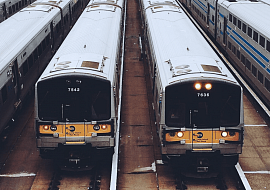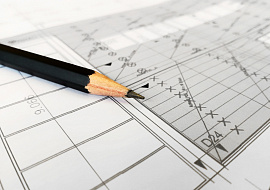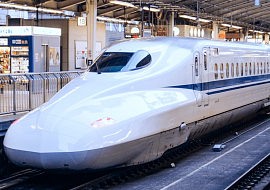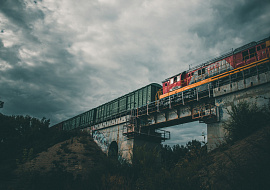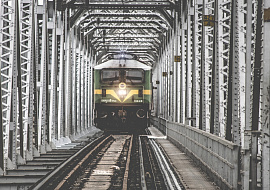Train Control Systems: Combining Conventional and Digital Technologies
This system has to “think” about train location and movement and therefore control speed, acceleration, and braking, as well as the distance between trains following each other, and report hazardous situations. Digital train control systems, unlike their predecessors, conventional methods, are more flexible, which results in the wide adoption of digital signaling solutions globally. As MMR reports, the train control systems market should grow at 8,9% by 2026. Growth should be steady, while most solutions regard digital signaling.
The most common train control systems – Positive Train Control (PTC), Communication-based Train Control (CBTC), and European Train Control System (ETCS) – although digital-based but permit the presence of legacy relay components within. Even entire rail sections with the legacy system installed can operate in parallel with the new control system. If to approach the rail signaling solutions development in detail, we can save money by choosing the appropriate combination of components for every rail project, whether we need signaling to upgrade or build the entire rail line from scratch. Proper management allows savings without compromising quality and missing deadlines. Given the previous, PSA wants to figure out how to successfully perform train control system updates in compliance with safety requirements.
Train Control Systems: The Place of Signaling System
As we outlined between the lines, the signaling system holds a key position regarding train control. It is the signaling system responsible for the train movement: only after making sure there are no other trains nearby the system permits the train to move further. To report information, it connects all the parties involved in train moving, namely, wayside, back-office, in-cab, and platform devices, to set up parameters for the safe movement of trains. That’s why we mean its signaling system first when talking about the train control system.
Since all train systems are interconnected, we must consider them when automating train control systems. The type of signaling system influences the speed, acceleration, interface of the dispatcher’s workplace, and so on. Thus, talking about digitizing the train control system, we are also talking about involving the following methods:
- Automatic Train Control – for speed control, smooth acceleration, and braking
- Automatic Train Operation – for driverless moving
- Automatic Train Protection – for checking speed and inducing automatic stop
- Automatic Train Supervision – for scheduling and route building
These systems generally become a part of CBTC, PTC, or ETCS. For instance, CBTC implementation eliminates the need for the driver – all operations are performed automatically. Moving blocks calculation allows setting a maximum allowable speed of train movement.
Benefits and Drawbacks of Digital Type of Train Control Systems
- Possibility of providing more services
- Faster recovery after failures
- More energy saving
- Smooth acceleration and braking
- Improved asset management & predictive maintenance
Digital signaling made it possible to increase capacity without constructive changes on the rail line. Virtual moving blocks and continuous monitoring of train location allow more trains to pass by some time while maximum speed is potentially unlimited. The other essential consequence of utilizing such systems is less deterioration of rail tracks and wheels and fewer downtimes. That means rail companies need fewer resources to spend on maintenance first and second – better customer experience in both freight and passenger transportation. One more advantage of digital signaling systems that will become critical for the future – is their connectivity potential. Connected trains are a significant part of smart city infrastructure.
Disadvantages of digital signaling system include:
- Cybersecurity risks
- Costly development
- Lower resistance to climate factors
However, as practice shows, the cost is the only drawback that significantly affects the decision on the signaling systems and components to choose when upgrading the rail line. Technical defects are always solved, while cost is a decisive factor when we talk about tens and hundreds of miles of the rail network and thousands of equipment units. Thus, let’s outline how to upgrade the train control system efficiently.
How to Rationally Combine Train Control Systems of Different Generations
Today, combining different signaling systems or their components within one rail network is standard. Moreover, such solutions are budget-saving if you cope with compatibility issues. Further, we outlined some options where it’s better to introduce new train control systems in the existing rail network and how it can be performed.
- Utilize conventional and digital systems in parallel. It is beneficial to use the traditional signaling system as an analog and launch it in case of failures, which allows no interruption of transportation processes while searching for a reason for a signaling failure. Saving millions of dollars and tens of thousands of hours that the US annually spends on downtimes caused by signaling failures.
- Leave the relay logic partially. By leaving relays for interlocking system operation and connecting them with microprocessors on-site, the system becomes electromechanical, which is the most efficient way of its utilization. It can be performed if the rail network doesn’t serve metro or high-speed rail.
- Leave the conventional system on the part of a rail section. It is justifiable to leave a traditional design on low-loaded rail sections. Special linking schemes are developed to allow the train to travel freely from one sector to another.
How to Overcome Concerns of Rail Projects While Implementing Train Control Systems
Commissioning new train control systems on the existing rail line traditionally leads to many concerns. They are due to the features of the rail industry, and it’s hard to fight them despite the vast global experience for such systems adoption. PSA is looking inside signaling upgrading projects, so we can give you tips on overcoming the most spread concerns.
Missed deadlines – Consider as many factors as possible
Unfortunately, missed deadlines are not a problem but the order of things in signaling-connected projects. This is predominantly due to plenty of subcontractors and inconsistency between them – sudden changes with one party logically lead to changes in the whole project. The other issue is legacy documentation that doesn’t reflect the on-site problem. To assess all the risks rationally, it needs to consider the age of the rail line and admit the possibility of documentation inconsistencies. Always introduce overtime on documentation changes. The crucial thing is to employ a project manager or managers experienced in rail projects to keep in touch with all the subcontractors and timely report the changes to all the involved parties.
Incompatibility issues – Update the system and simulate scenarios
Incompatibility is more likely between legacy and cutting-edge microprocessor systems than between relay and microprocessor systems. It is essential to establish reliable communication because signaling failures happen. To avoid this, developers must update one or both systems or utilize STM to interfacing with legacy signaling systems. One more crucial moment is to simulate the solution before commissioning. Simulate various interlocking scenarios for the microprocessor-based controller to be sure it operates properly.
The increasing complexity of the system – Prepare the team
Here we talk about complex software and hardware in contrast to relatively simple conventional signaling systems that are naturally connected with the other train systems. There are technical difficulties in implementing the design and how to operate and maintain it after commissioning. For instance, the new signaling system gives advanced opportunities for predictive maintenance and can communicate directly with the technical team tablets. This system must be estimated long before implementation while the team prepares for work in a new environment.
What PSA Can Do for You
-
Replacing the legacy system with the new one always leads to more significant concerns than implementing the cutting-edge system on the new-built rail line. To seamlessly move from one signaling system to another, PSA offers a team of 10+ years of experience engineers with a correspondent rail college degree. We offer:
- Estimate the project needs according to its scale, location, existing documentation, and ultimate goal.
- Perform high-quality rail signaling system design and detailed info about materials, dimensions and tolerances, authenticity, and productivity.
- Develop supportive tools for the train control system and perform verification activities for the wayside, back-office, in-cab, and platform equipment.
- Support the project at a factory and on-site to ensure the successful commissioning of the updated rail network.
We are looking forward to seeing you among our reliable partners!








